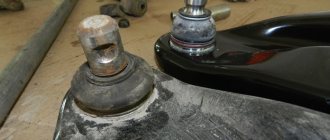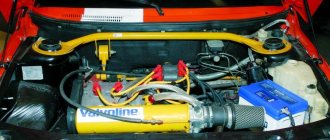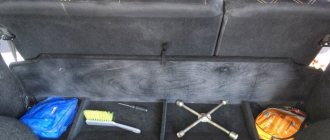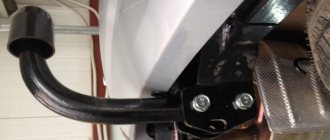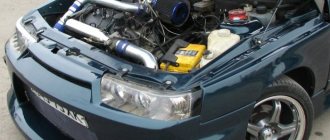Cars admin26.02.2020
Lada Largus is a high-capacity station wagon produced by AvtoVAZ and is quite popular among domestic car enthusiasts, despite some shortcomings that drivers fix on their own.
By the way, the practice of these modifications is adopted by the engineers of the car plant and partially introduces them into production.
Some modifications made by car enthusiasts are taken into account during production
Modification of the rear wiper
Unfortunately, the rear wiper operating mode on the Lada Largus does not have an intermittent mode - when turned on, it works constantly.
To switch the wiper to work with a variable pause, use:
- wiper relay marked 723.3777;
- standard 4 or 5-pin connector for automotive relay;
- round terminals;
- terminals 3 mm wide (“male + female”);
- pieces of wire;
- heat shrink tubing for insulating connections.
To connect an additional relay, ground wires are used that have black markings on the steering column switch block (third from the right on the side of the wires), as well as turning on the rear wiper (white, second from the right) and turning on the rear washer (gray, far right).
The rear wiper of Lada Largus can be modified by installing an additional relay
An additional relay is installed in the gap between the block and the wire route. At the same time, in order for the electrical circuit to be returned to its original state without any problems, standard connectors and terminals are used to connect an additional relay.
The principle of the modification is that when the rear wiper is turned on, the voltage previously supplied to it directly is now supplied to an additional relay, which, after modernization, controls the operation of the wiper, providing the necessary pause between strokes.
An additional advantage of using this relay is that when the rear washer is turned on, the wiper automatically switches to continuous operation mode, and after 3-4 cycles it again switches to pause mode.
The entire structure is mounted next to the steering column switch and secured with plastic clamps.
Let's sum it up
Lada Largus Cross is a model that allows its owners to perform a wide variety of tuning and introduce all innovations to an unlimited extent. At the same time, you can do almost everything with your own hands. Here the main factor may be the financial component, which often determines in which direction tuning should be developed in a particular case. If this aspect does not concern the owner who is prone to transformation, then desires and preferences come to the fore.
The result of tuning the Lada Largus Cross will be not only a satisfied owner, but also a significantly transformed car; all innovations are the path to individuality, which is so rare in our time.
Installing a handbrake warning light
The parking brake, according to reviews from Lada Largus owners, is quite powerful for this car. So attempts to move with the handbrake raised usually end in failure.
Although slightly releasing the handbrake, even after several tens of meters of movement, does not add life to the rear pads.
To protect your brake pads, install a handbrake warning light.
In order to avoid such curious mistakes when starting to drive, especially since the standard “handbrake raised” alarm lamp is not very informative, some motorists install an additional handbrake alarm unit.
The unit itself is commercially available, and its connection is quite simple.
The unit itself has four wires for connection. They all connect to a black connector that matches the instrument cluster.
Color coding and connection:
- the positive from the ignition is connected to pin 10 (yellow wire);
- a speed sensor is connected to pin 22 (green wire);
- the remaining two gray wires are connected to slot 16 (gray wire).
Now, if you start driving with the handbrake raised, a buzzer will sound and the parking brake lamp on the instrument panel will begin to blink.
Automatic door locking when a certain speed is reached
It is worth noting that this function is available in many additionally installed alarms, however, Lada Largus owners can activate it themselves, using only the standard car system.
To activate the automatic door locking function, minimal intervention in the standard wiring of the car is required, as well as the presence of a special adapter for connecting the UCH (central electronic switching unit in the cabin) to the computer and special software.
An adapter for connecting can be purchased both in online stores - there are now many of them - and in regular stores that sell diagnostic equipment, as well as made independently (for those who have at least minimal skill in assembling electrical circuits).
Automatic door locking while driving is very convenient
So, at the first stage, you need to send a signal from the speed sensor to the UCH. To do this, connect a wire from pin 22 of the left connector of the instrument cluster to pin 6 of the brown insert on the black UCH connector. Using this wire, when a +12V control signal is applied to it, when the speed determined in the next step is reached, the doors will be locked.
Now it is necessary to determine the speed threshold, upon reaching which the locking will occur.
To do this, connect a computer or laptop using an adapter to the diagnostic connector and in the running program (for example, DDT2000), the door locking function is enabled, and the speed threshold is set.
The feature is now enabled, but not yet activated.
To activate the function in Lada Largus, you need to press the lock button located on the instrument panel and wait for a sound notification (about 5 seconds), which indicates successful activation. To turn off the automatic locking of the locks, you must perform this operation again by pressing, on the contrary, the unlock button.
avtoexperts.ru
Absolutely any car can be tuned and improved, Lada Largus is no exception. However, this car differs from other models in its class. If the modifications of other cars are often of a typical nature and are the same for all cars (cooler music, xenon, lenses, armrest, sound insulation, and so on), then Largus has tuning areas that are typical only for the VAZ station wagon and which make a lot of sense for other cars Dont Have. This is exactly what we want to talk about in this material.
Replacing fifth gear gears
This, of course, is nonsense, but intervention in the gearbox is one of the most popular tuning options for Largus. It's all about the mocking selection of gear ratios on cars with new engines. There is no point in nodding towards VAZ engineers here, because they received such a setup along with a production license; in Europe, the Dacia Logan MCV is produced with the same gearboxes. What is the problem? The box is very short. In the highest, fifth gear, at 3000 rpm, the car travels only 91 km/h according to the navigator. Normal cruising speed of 120-130 km/h, allowed on toll sections, already requires 4000-4500 rpm. It is uncomfortable to drive for a long time at such a speed, because the engine roars as if it was about to take off. And fuel efficiency suffers from this setup.
Surprisingly, the problem is most pronounced on cars with a 16-valve engine, which have the shortest gearbox. The van and modifications with an 8-valve power unit have different gear ratios, also short, but more humane for the driver. So, an 8-valve 5-seater Largus at 3000 rpm will travel about 100 km/h according to GPS. Already more or less. Any automotive student knows that the weaker the engine, the shorter the box it needs to hide the lack of horsepower, while on more powerful engines you can put long pairs, because the engine will still take out. But this truism is inaccessible to the understanding of French engineers.
Considering that Largus’ 16-valve engine is the most popular, the problem is widespread. Fortunately, it turned out that it is possible to change the fifth gear gears on a Renault gearbox without removing and disassembling the unit. The highest speed is located directly behind the removable cover, and just on the side with good access. Technically, the replacement looks like this: you need to remove the wheel, wheel arch liner, unscrew the bar, drain the oil from the box, unscrew the box cover, remove the old gears, install new gears and reassemble in the reverse order. You need good pullers for the job, because the hardest part of the process described above is removing the old gears. If you don’t have the necessary equipment and don’t want to buy it for one time, then you can contact any service center to ask for a replacement. They will charge 2-2.5 thousand rubles for the work.
Another question is what to put. In total, Renault produces five gear options for JH3 gearboxes, which provide different gear ratios: 0.892; 0.820; 0.795; 0.756; 0.738. As you might guess, 16-valve Largus have the shortest ratio - 0.892, so any replacement will improve the situation. But the owner needs to choose for himself what specific ratio to set. The optimal option is 0.795 - and the speed on the highway is reasonable (at 3000 approximately 102 km/h according to the navigator), and the dynamics are maintained. But for some reason this particular set turns out to be the most expensive. To save a little, you can take 0.756, which at 3000 rpm will have 105 km/h. The longest option is uncomfortable, because between 4 and 5 speeds there is a huge gap and at a speed of 70 km/h it is uncomfortable to drive in any of these gears.
After replacement, fuel consumption on the highway usually drops, but not very much: by 200-400 grams. It will not be possible to recoup the costs of replacing gears with fuel - the difference is too small, and gears cost about 5-6 thousand rubles. The main point of tuning is a comfortable ride on the highway. After the replacement, you can drive relatively quickly and not hear the straining roar of the engine. This is also worth a lot.
Note that replacing the gear is only relevant for passenger Largus. The van already has the longest 0.738 from the factory, but it works in combination with a “cargo” main pair of 4.928, which compensates for the length of the fifth gear itself. But you can’t easily change the main pair in the box.
In addition, all of the above is typical only for models with a Renault engine. When switching to VAZ engines, engineers changed the entire number of gears, so now the Largus can be comfortably driven on the highway straight from the factory.
Spare wheel on the trunk door
A spare tire on the tailgate is considered the preserve of jeeps. But on Largus this element is found very often. Why? The VAZ station wagon is perfect for installing LPG, and the cylinder simply fits perfectly under the rear overhang, in place of the spare wheel. But then where to put the spare tire? In the five-seater version you can simply throw it in the trunk, but in the seven-seater you can’t do this - it just doesn’t fit in width between the seat back and the door. Out of desperation, I have to mount it from the back, fortunately several companies have started producing brackets.
Ignition switch illumination
Illumination of the ignition switch is a rather convenient “feature” when the car is frequently used at night in poorly or unlit places.
To modify the ignition switch and install the backlight, a minimum of parts are required, and all the work, including the connection, takes about an hour.
After some simple manipulations with the ignition switch, you will not experience any difficulties when using the car in the dark.
To work you need:
- LED of small diameter, for example, 2.5–3 mm;
- resistance 1–1.5 kOhm;
- the wire.
To install the backlight, you need to remove the lock cover. It is removed together with the immobilizer antenna, and then remove the top cover of the casing.
At the second stage, the LED is installed inside the lock housing. To ensure uniform illumination, small slits can be made in the housing, after which the casing is assembled and installed in place. The wires coming from the LED are pulled to the CEBCS unit and connected to the white connector. To connect the wires, you can use gray or white wires - this is a “minus”. For “plus”, either of the two red wires is used.
Connecting to the CEBKS unit allows you to get the lighting to work similar to turning on the interior lamp - it lights up when the Lada Largus is disarmed, when the doors are opened, and goes out either after the doors are closed or after the ignition is turned on.
Lada Largus
| ECU type | Engine capacity | Power before/after | Torque before/after | Price, rub. |
| M86 | 1.6 8V | 82/90 | 120/136 | 6000 |
| M86 | 1.6 16V | 106/127 | 148/167 | 6000 |
| EMS 3132 | 1.6 8V | 82/90 | 120/136 | 7000 |
| EMS 3132 | 1.6 16V | 106/127 | 148/167 | 7000 |
Refinement of the stove motor
This part, probably, would have been better called “Refinement of the heater motor activation mode”, since we will be talking specifically about eliminating a kind of “bug” - the operation of the interior heater when the ignition key is turned to the ACC position.
Indeed, the functionality of the interior heating system is in big question when the “stove” motor is turned on and the engine is not running - there is no circulation of coolant, and the coolant in the “stove” will quickly cool down and stop heating the interior.
The interior heating system of the Lada Largus can be modified in several ways
For Largus owners, there are two ways to change the operating mode of the heater motor. And both, unfortunately, require intervention in the electrical circuit of the car.
First
The first way to change the operating mode of the interior heater simultaneously with turning on the ignition is to move the wire that controls the heater relay from its standard location to any terminal that receives + 12V when the ignition is turned on. This could be, for example, a reverse switch or a fuel pump relay. That is, the thin yellow wire going to the “stove” motor relay is cut off and connected to any of the above locations.
Results
As you can see, Lada Largus allows its owners to go wild in terms of tuning. It is important to choose one or another modernization option carefully, taking into account your desires, preferences, improvement goals and, importantly, capabilities. Don’t forget, tuning a car is a rather expensive undertaking that may require investing a considerable amount of money into its implementation.
Summarizing the previously presented material, we can draw the following conclusions:
- In terms of the technical part, you can improve the Lada Largus in two main ways: by tuning either the engine or the suspension. The first upgrade option will help improve the dynamics of the car, and the second will help improve its stability.
- If priorities in tuning are given to appearance, then restyling the exterior of the body is optimal. You can also modernize the interior of the car, but this measure is aimed at increasing aesthetic comfort specifically for the people in the car.
- The remaining tuning options are more or less applied to the two main ones mentioned in the two previous paragraphs. An additional type of modernization is determined taking into account the preferences of a particular car owner.
In general, you can do tuning of the Lada Largus with your own hands if you know what exactly needs to be improved and have some car repair skills. In other cases, it is better to entrust modernization to professionals with a service station. We hope the material presented above will help you determine the vector of your movement in tuning your car. Good luck with the modernization and on the roads!
Video review of how you can tune the Lada-Largus-Cross:
How to upgrade a mediocre Lada Largus station wagon to a top version for little money?
LADA > Largus
Largus is a great car. There is no alternative to it in the class of affordable seven-seater cars. But after the March price increase, they began to ask a lot of money for it: a seven-seater version (there is also a five-seater) with an 84-horsepower engine is priced at 549,000 rubles. And this is the initial performance of “Norma” - no luggage rails, no “music”...
Operation of electric windows when the ignition is turned off
Quite often, Lada Largus owners complain that the power windows do not work when the ignition is off or the key is in ACC. This can be corrected by a small modification of the car's electrical circuit.
Video on how to make power windows work on a Lada Largus without ignition:
To perform this work, you must remove the interior fuse box.
It is worth recalling that this modification, like the previous one, must be carried out with the battery disconnected!
First of all, you need to find fuses F13–F16, which are responsible for the functionality of the ESP, after which, carefully bending the terminal clamps and pulling out the plastic clip, remove the power supply strip.
The removed strip is divided transversely into two parts. The first part returns unchanged to the place corresponding to fuses F15 and F16.
A thick copper wire with a cross-section of approximately 1.5 squares is soldered to the remaining second half, which, in turn, is soldered (screwed) to any thick wire that receives power when the key is turned to the ACC position (or has constant voltage - as you like).
The modified half of the strip is installed in place, the mounting points are isolated, the fuses are returned to their place and reassembly is carried out in the reverse order of disassembly.
Hello, dear friends! Today we will be a little creative, reflect and prepare the ground for further action. And why all? Yes, because the topic of our conversation will be tuning the Lada Largus.
This is a popular car in Russia and the CIS countries, which is closely associated with the French auto company Renault and received a lot from it. Therefore, the current Lada Largus compares favorably with outdated domestic station wagons.
Yes, Largus is a full-fledged station wagon or van, as some are used to saying. Even the presence of the prefix Cross in the name does not make it a full-fledged crossover.
I would like to discuss with you possible improvements for the Lada Largus, and also separately tell you a little about the Cross version. If you are ready, then we can begin.
photos and instructions :: SYL.ru
The Lada Largus station wagon is especially popular in the domestic automobile market. Jointly developed by Renault and LADA, it is a reliable and high-quality car. At the same time, it has a very mediocre design with not the best dynamic performance and technical characteristics. For this and many other reasons, car enthusiasts tune the Lada Largus, resorting to a variety of modification options.
Of course, no matter how hard you try, you won’t be able to make a sports car out of a family station wagon, but you can improve dynamic performance, reduce fuel consumption and add fresh and original notes to the car’s design. So, tuning the Lada Largus: all the innovations and ways to create an attractive car from a boring station wagon.
Engine chip tuning
Chip tuning of Largus allows you to reduce fuel consumption and increase engine power and performance. Such adjustments are made to the car only if its engine is fully operational. Before starting work, service station specialists must diagnose all vehicle systems using special equipment. Reprogramming the control unit allows you to change the basic parameters of the motor. You can return to factory settings at any time by resetting the system.
Largus chip tuning is carried out in the presence of the car owner after all the nuances and the desired result have been discussed with a specialist. Reflashing the electronic control unit allows you to eliminate many malfunctions and problems of systems - for example, “short” gears. The changes made make driving more comfortable and convenient, extending the life of the main components and assemblies.
Of course, this type of tuning allows you to solve many problems with the operation of the car, but you should not rely on a significant reduction in fuel consumption: the Lada Largus has quite considerable appetites. It is simply impossible to achieve a reduction in consumption by five to six liters by flashing the ECU, but it is still possible to reduce it a little.
Exterior tuning: new appearance
The design of the Lada Largus, despite all the advantages of the car, leaves much to be desired. However, you can change the state of affairs by making certain adjustments to the exterior. Tuning a Largus in most cases starts with optics: purchasing high-quality fog lights and lensed headlights. You can install PTF and other optics on your own, without resorting to the services of service station technicians.
One of the simple and effective options for tuning a car is to cover individual parts of the body - the hood, roof and pillars - with black film. Carbon film is a decorative material that must be used in doses, otherwise you can achieve the opposite result and ruin the entire appearance.
To tune the Largus, you can purchase ready-made body kits consisting of chrome-plated and rubberized elements. The parts are installed on bumpers and door sills in a matter of minutes, which gives the Lada sophistication and originality. In the luxury configuration of LADA Largus, special roof rails are available. However, such elements are included in standard kits, which can be purchased at automotive stores.
The next tuning step is to replace the original wheels with cast ones, which will definitely refresh the exterior of the station wagon.
Tuning the interior of Lada Largus
The interior, like the exterior of the car, leaves much to be desired: the crude execution of the parts is off-putting and requires a complete remodel. In this regard, internal tuning of Largus almost always begins with replacing the dashboard. As an alternative, you can choose more stylish analogues in stores, equipped with LED lighting. If desired, the instrument panel can be supplemented with a multimedia system, display, navigator or video recorder.
In a Lada Largus car, tuning the interior often involves installing additional lighting not only in the passenger and driver's seats, but also in the trunk. Since this model is a family model and has good capacity, its main purpose is to transport goods. Additional lighting will make it easy to unload and load various items even in the dark. Installing lighting does not require large expenditures from the car owner: it is enough to connect several LED strips powered from the car’s on-board electrical system.
The absence of a cabin filter in a car negatively affects the cleanliness of the incoming air. This problem can be resolved quite easily, especially since the Largus still has a standard air conditioner.
Replacing seats: comfort and ease of travel
Despite the apparent comfort and convenience, the seats in the station wagon leave much to be desired: during long trips, their inconvenient anatomical shape and design begin to have an unpleasant effect on well-being. For this reason, many tuning studios offer a complete replacement of all seats with more comfortable and high-quality analogues with lateral body support.
Car soundproofing
The disadvantage of not only the Lada Largus, but also of many other domestic cars is the poor sound insulation of the interior. You can improve it through tuning. The car owner can carry out such a procedure on his own, but often they turn to specialists at service centers for such services.
Safety first
Installation of security systems, car alarms and various blockers also refers to the types of tuning of the Lada Largus car. Tuning (photo examples of which you see here) of this type minimizes the risk of car theft. One of the most effective ways to protect your car is to install a steering shaft lock and an alarm system with an immobilizer function.
vote
Article rating
Say a word about Largus Cross
The Cross version is the case where changes can be kept to a minimum. If I had a choice between Largus and Largus Cross, I would without a doubt take the second one. And I would recommend this to everyone.
The car initially, if taken in a good configuration, minimizes the need for tuning. Everything I said before applies here.
But in practice, only some of the improvements are really useful in this case. I explain my position. The Cross version initially offers:
- original body kits;
- wheels with a diameter of up to 16 inches with beautiful designs;
- roof rails, regardless of configuration;
- rear parking sensors, regardless of configuration;
- improved suspension struts (with them it’s not so scary to drive off-road);
- modified seats with good lateral support and increased comfort compared to the regular Largus;
- beautiful door cards and panels;
- interesting dashboard along with the dashboard;
- leather steering wheel;
- The standard audio system already has 6 speakers (but I would still install multimedia).
Yes, most car owners don’t need more. The main thing is to initially buy a car with a rich configuration. Then tuning your Largus Cross comes down to a minimum set of modifications.
Don’t forget that AvtoVAZ offers several features for Cross from the factory. Namely:
- tourist roof box for 10 thousand rubles (excellent quality and appearance);
- off-road tires (approximately 3-6 thousand rubles);
- standard tinting (complies with GOST, does not raise questions from the traffic police, costs about 10 thousand rubles).
By paying about 30 thousand extra, you get a car in full combat readiness.
This is not an exemplary SUV, but an all-terrain station wagon. But considering the price of the car, its technical characteristics and level of comfort, it completely justifies itself. What do you think, is it worth doing tuning in the case of the Lada Largus and what changes are you ready for?
Thank you all for your attention! Subscribe to our website, leave comments, ask questions and invite your friends to discussions!
( 6 ratings, average: 4.67 out of 5)
Did you like the article?
Subscribe to updates and receive articles by email!
We guarantee: no spam, only new articles once a week!
Lada Largus appeared in Russia not so long ago, but has already become popular among car enthusiasts. The model belongs to family cars, the main purpose of which is the transportation of things, cargo and out-of-town trips. One of the versions of Largus is Cross, which has some differences both in appearance and in technical characteristics. But since this is a domestic car, many owners make various modifications to the car.
Tuning options
Here we are not dealing with crossovers and SUVs in their pure form, as was the case with the UAZ Patriot and the more expensive Pajero Sport. Therefore, I don’t see any point in focusing on off-road tuning. A station wagon remains a station wagon.
I can hardly list all the innovations available for Largus. Therefore, we will divide the improvements into 3 main categories:
- external;
- internal;
- technical.
Don't try to make a racing car out of Largus. This is not the case. Here is a family car, which would be much better equipped with the following characteristics:
- dynamism;
- efficiency;
- style;
- increased comfort.
How to achieve this? We'll figure it out step by step. Much depends on how much effort and money you are willing to invest in the car. Some get by with minimal changes, others change the van beyond recognition in order to stand out clearly against the background of the gray stream of standard Largus and more.
Let's start with the interior, then gradually move on to the body and finish it all with technical modifications available to most car owners that do not require large financial investments.
Decide in advance whether you will do everything yourself, or simply collect information and options for ordering work from a tuning studio. This is important, because not everything can be implemented on your own without special equipment and professional tools.
I’ll tell you the most current options, and then everyone will make a decision for themselves.
Salon
To modernize the interior, all kinds of accessories are available that can be purchased in Yekaterinburg, Minsk, Moscow, St. Petersburg, Kyiv, somewhere in Kazakhstan, etc. If there are problems with stores in your city, an online store is always available.
What can be changed inside the car? Let's go through the main points.
- Seats. They are not of the highest quality and do not provide sufficient comfort. Lateral support leaves much to be desired. Budget tuning involves purchasing covers, but they won’t really change the structure of the seats. You can alter the interior by adding bolsters and changing the design a little. For drastic measures, completely remove the old seats and replace them with sports chairs;
Do-it-yourself Largus Cross tuning
Modernization of the model is mostly aimed at increasing the level of comfort, reducing fuel consumption, increasing dynamics, and improving appearance.
Engine
One of the options for tuning the car in question is to improve the power unit, which is capable of developing from 102 to 106 hp. depending on the settings and features of the motor. For a measured ride, these characteristics are quite enough. However, there are car enthusiasts for whom the standard power is not enough. You can modify the engine in the following ways:
- perform chip tuning by flashing the electronic control unit;
- change characteristics by replacing engine parts.
Chipovka
The most popular option for upgrading a power plant is chip tuning. If the work is carried out in a specialized service, where the unit is flashed with a program with properly calibrated parameters, then you can get greater dynamics from the car. Depending on your wishes, the electronic unit can be re-flashed to suit your needs:
- reduction in fuel consumption;
- reduction of exhaust toxicity;
- improvement of dynamic performance.
Reprogramming the unit yourself is not recommended, as there is a high probability of side effects. High-quality work costs about 4–10 thousand rubles. As a result of its implementation, it is possible to improve the elasticity of the engine and reduce consumption by 1.5 liters per 100 km. If the results of chipping seem insufficient to you, then you need to engage in more global modernization.
Technical improvement
Intervention in the design of the motor can improve the initial power characteristics by 10–40%. Refinement involves intervention in the following nodes:
- supply system;
- gas distribution mechanism;
- injection elements;
- cylinder-piston group.
Chassis
If the owner of the Largus Cross is not satisfied with the characteristics of the suspension, changes can be made to it. Through modifications you can improve the driving performance of the car. Changes can be aimed at the following actions:
- installation of reinforced suspension elements;
- increase or decrease in clearance;
- installation of parts with improved characteristics (stands, stabilizers, etc.).
The clearance of the Largus Cross is 170–195 mm, depending on the configuration. These indicators are quite enough for confident driving both in the city, on the highway, and for trips into nature. If the ground clearance seems too low, it can be increased by installing special spacers for the shock absorbers. These parts are mounted between the cup and the racks.
There is also a more complex and expensive option for increasing ground clearance: replacing shock absorbers and springs or installing larger wheels. As for reducing the ground clearance, in relation to the Largus Cross this procedure is simply inappropriate, unless the goal is to make the car an exhibition piece.
Modernization of the body of the Largus model
We have seen that in some cases it is not difficult to transform the characteristics of a motor, although an infusion of a certain financial resource is required.
What should an owner do if he is “satisfied” with the modernized engine, but is not satisfied with the appearance of the body? Here the saving measure will be a transformation in the exterior of the Lada Largus.
In this case, you can also lean towards two courses of action:
- perform structural transformation of body components;
- so-called cosmetic modification.
The first option involves replacing some body elements with new products, usually of an individual design. Note that a well-executed modification of this nature can not only significantly transform the exterior of the car, giving it speed and sportiness, but also significantly improve aerodynamic performance.
The most common structural modifications that most owners of Lada Largus Cross are inclined towards are the following:
- spoiler installation;
- installation of body kit on the hood (linings, buckets, intakes, etc.);
- replacing head and rear optics with more advanced and powerful lighting designs;
- the use of reinforcing components around the perimeter of the body (front grille, protective linings, skirts, etc.);
- installation of new wheels complete with tires instead of standard products;
- replacement of bumpers, exterior mirrors, etc.
Naturally, such transformations cost a lot of money and require the allocation of significant time resources.
A simpler version of the transformation will be cosmetic tuning. It involves the implementation of activities in the following areas:
- updating the paintwork of the body;
- tinting of glass, as well as optical devices;
- airbrushed designs on body panels;
- wrapping the body with various polymer materials (carbon films, vinyl, etc.);
- use of additional LED lighting sources.
Such events can provide the Lada Largus Cross with an updated look, allowing it to stand out in the gray mass of traffic. The main advantage of this method is its low cost.

